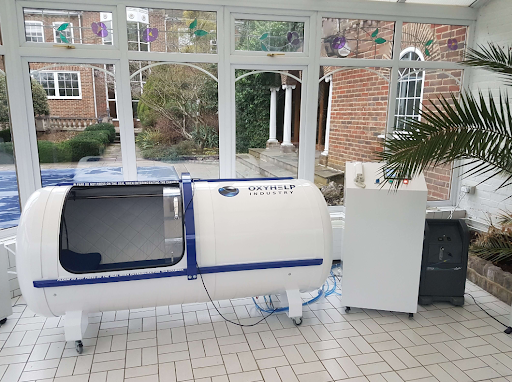Hungarian-born scientist Edward Teller, the creator of the hydrogen bomb and a former science advisor to President Reagan, had a stroke at the age of 74. Richard Neubauer, his physician, informed him about an alternative medical procedure that would help him regain his health, mobility, and cognitive function.
Teller recovered nearly instantly after following Neubauer’s recommended course of therapy.
Dr. Neubauer suggested pure oxygen administered under pressure as a therapy. Within the first few therapy sessions, Edward claims that the remnants of his stroke vanished. After being exposed to pure, pressured oxygen, Edward’s wife, who also had lung issues, saw alleviation from her illness.
Later on, the medical care that Edward Teller got would be referred to as hyperbaric oxygen therapy, or HBOT for short.
HBOT is a medical procedure that has received FDA approval. In this procedure, a patient receives 100% pure oxygen through an enclosed chamber with elevated atmospheric pressure. Delivered at pressures above normal, oxygen dissolves and is forced deep into the blood plasma, cerebral fluid, lymph fluid, and blood cells.
Teller was so delighted with hyperbaric therapy’s efficacy after his first HBOT session that he went out and bought a hyperbaric chamber for home use. Until his death at the age of 95, it is believed that he spent an hour inside of it every single day.
Several testimonials supporting the advantages of hyperbaric chambers include those of Edward Teller and his spouse. When HBOT first appeared as an alternative to conventional medicine, it had not gone far; today, 1,500 out of 2,000 institutions in the country use it as a therapeutic option.
Table of Contents
People Made Fun of the Earlier Hyperbaric Pioneers
A remarkable recovery made with nothing but pure, pressurized oxygen would have made many physicians chuckle even twenty years ago.
Some did more than just laugh, in fact. The medical community harshly criticized the forerunners in HBOT, dismissing their results as “absurd,” despite a growing body of reliable data and encouraging patient testimonials.
The advantages of hyperbaric oxygen treatment are still viewed with some skepticism by many medical professionals and patients today. For a disease as complicated as anemia, gangrene, or cyanide poisoning, using anything as basic as a breathing agent would seem like an overly easy treatment.
Apart from their growing use in clinical settings and rising prevalence, home hyperbaric chambers are becoming more and more popular. As more and more patient success stories come to light, hundreds of people seeking oxygen therapy benefits are increasingly buying hyperbaric chambers for use at home.
Patients who lead busy lives or who just wish to be able to jump into the oxygen-rich atmosphere whenever it’s most convenient for them may find this quick access to HBOT fascinating.
In addition to the thirteen FDA-approved applications, HBOT is used to treat a wide range of developmental, physical, and cognitive impairments. Purchasing a personal HBOT chamber frequently indicates a person’s intention to use the therapy for a variety of off-brand purposes, including anxiety disorders, depression, multiple sclerosis, Parkinson’s disease, autism spectrum disorder, and insomnia.
The Development of Hyperbaric Medicine Began with Deep-Sea Diving
Despite the fact that pressurized gas has long been used in medicine, hyperbaric oxygen therapy may appear like a relatively recent treatment.
Deep-sea diving history is strongly associated with the development of hyperbaric medicine. Divers do not know where diving originated, however it is said to have started around 5,000 years ago with breath-holding divers.
When doing a range of activities, including ship salvage, spearfishing, and the collection of pearls, coral, and sponges, the early divers would take a single breath and descend down under the surface.
A glass vessel is said to have been used to drop Alexander the Great into the Bosphorus Straits, providing him a significant advantage during the siege of Tyre.
The Hyperbaric Chamber Was Invented Over 300 Years Ago.
Hank Henshaw, a British physician, invented the first hyperbaric chamber in 1662. He gave it the name “Domicilium” and used an organ below to manually pump natural air into the airtight container.
Henshaw conducted a series of studies with different atmospheric pressures and found that although those with acute problems responded better to an atmosphere with higher pressure, those with chronic illnesses found relief from symptoms when there was less pressure in the chamber.
Henshaw utilized his observations to independently conclude—in the lack of scientific proof—that patients with acute illnesses would benefit from higher atmospheric pressure, whereas those with chronic illnesses would benefit more from a rarefied climate.
Domicilium, according to Henshaw, would aid in digestion, make breathing and expectoration easier, and generally be a great therapy for a wide range of upper respiratory conditions.
Notably, unlike many contemporary hyperbaric chambers, Henshaw’s chamber functioned with ambient air rather than pure oxygen and instead depended only on the effects of fluctuating atmospheric pressure.
Nevertheless, Henshaw’s creation served as an effective model for other hyperbaric pioneers and established a noteworthy foundation for future scientific research into the field of hyperbaric oxygen treatment.
Oxygen Discovery Was Preceded by Hyperbaric Chambers
The English scientist Joseph Priestley did not find oxygen until 1775, despite the fact that hyperbaric treatment had been in use since 1662.
Many scientists were initially doubtful about the advantages of pure oxygen and reluctant to utilize it at higher pressures. Physicians did not have a better understanding of the possible benefits of employing hyperbaric oxygen in medicinal settings until 1917. This shift in perspective was closely linked to evidence-based choices to use an oxygen regimen to treat decompression sickness.
Many years later, the military created and experimented with hyperbaric chambers, especially for deep-sea diving and aviation.
In the 1960s, research adopted a broader perspective, emphasizing the extensive use of hyperbaric chambers.
Hyperbaric chambers are used by many professional athletes.
Celebrities who use hyperbaric treatment include professional athletes, however they may not be doing it for its anti-aging benefits.
NFL player Tim Tebow originally acquired his mHBOT device in 2008, and he became well-known for utilizing it to hasten his recuperation after strenuous workouts and sports sessions.
Olympic swimmer Michael Phelps and wide receiver Hines Ward of the Steelers are two more proponents of hyperbaric therapy’s regenerative properties, emphasizing how it may speed up healing by boosting blood flow to strained muscles and injured tissue.





